Evaluation of plant growth promoting rhizobacteria and mycorrhizal fungi for growth and nutrient uptake in pearl millet (Pennisetum glaucum)
Bạn đang xem bản rút gọn của tài liệu. Xem và tải ngay bản đầy đủ của tài liệu tại đây (619.13 KB, 8 trang )
Int.J.Curr.Microbiol.App.Sci (2017) 6(6): 2648-2655
International Journal of Current Microbiology and Applied Sciences
ISSN: 2319-7706 Volume 6 Number 6 (2017) pp. 2648-2655
Journal homepage:
Original Research Article
/>
Evaluation of Plant Growth Promoting Rhizobacteria and Mycorrhizal Fungi
for Growth and Nutrient Uptake in Pearl Millet (Pennisetum glaucum)
Prashant Singh1,6*, Hem C. Joshi2, Naveen Kumar3, Manish Dev Sharma4,
Aditya Patel6, Narotam Sharma6 and Veena Pandey1
1
Department of Biotechnology, Bhimtal Campus, Kumaun University, Nainital,
Uttarakhand, India
2
3
Department of Plant Physiology, Molecular Cytogenetics Laboratory, Department of Molecular
Biology and Genetic Engineering, Govind Ballabh Pant University of Agriculture and
Technology Pantnagar, India
4
Department of Life Sciences, 5Central Molecular Research Laboratory, Biochemistry
Department, Shri Guru Ram
Rai Institute of Medical and Health Sciences, Dehradun, India
6
Devsthali Vidhyapeeth, Lalpur, U S Nagar, India
*Corresponding author
ABSTRACT
Keywords
PGPR, Mycorrhiza,
Nutrient uptake,
Agronomical traits.
Article Info
Accepted:
26 May 2017
Available Online:
10 June 2017
Five bacterial cultures and one mycorrhiza culture were applied on seeds of
Pearl millet (Pennisetum glaucum L.). All the bacterial cultures and
mycorrhiza showed increased agronomical traits and enhancement in
nutrient uptake like potassium, nitrogen and phosphorus. Seedlings treated
with bacteria and mycorrhiza also analyzed for flavonoids, phenols and
super oxide dismutase (SOD). Increased level of phenols, flavonoids and
SOD confirmed microorganism effect on plant growth promotion. PS-05
and mycorrhiza were most effective in plant growth promoting activities.
Introduction
Current trends in agriculture are focused on
reduction in the use of chemical pesticides
and inorganic fertilizers, compelling the
search for alternatives that enhance
environmental quality (Haggag, 2002). The
management of soil organic matter requires
inputs of biological fertilizers, composts, crop
residues, green manure, and other organic
wastes. The role of microbes in maintaining
soil fertility is well known and recently plant
growth promoting microbes were identified
by researchers worldwide. Plant growthpromoting bacteria (PGPB) directly stimulate
growth by nitrogen fixation (Han et al.,
2005), solubilisation of nutrients (Rodriguez
and Fraga, 1999), production of growth
hormones,
1amino-cyclopropane-1carboxylate (ACC) deaminase (Correa et al.,
2004); and indirectly by antagonizing
pathogenic fungi by production of
siderophores, chitinase, β-1,3-glucanase,
antibiotics, fluorescent pigments, and cyanide
2648
Int.J.Curr.Microbiol.App.Sci (2017) 6(6): 2648-2655
(Renwick et al., 1991; Pal et al., 2001).
Majority of known plant growth-promoting
rhizobacteria (PGPR) are isolated from
rhizosphere (Khalid et al., 2004). However,
their ability to colonize roots and survive in
soil is often limited (Normander and Prosser
2000). Identification of more potent bacteria
and fungi can broaden the spectrum of PGPB
and mycorrhiza that can survive and perform
well in soil conditions.
Pearl millet [Pennisetum glaucum (L.)] is the
main coarse grain crop in semi-arid regions
and is grown in India as rain-fed or irrigated
crop on 10 million hectares producing 7.01
million tons (Bhatnagar et al., 2002). Pearl
millet is a crop of marginal land, provides
staple food for poor in semiarid regions of
Asia and Africa. Improving the soil fertility
and millet production without the use of
chemical fertilizers is a difficult task (Raj et
al., 2003). But chemical fertilizers have
detrimental effect on soil hence PGPR and
mycorrhiza use may be best approach for
millet production. PGPR-mediated plant
growth and control of plant diseases of pearl
millet is an alternative eco-friendly approach
(Kloepper, 1993).
In the present study, effect of previously
isolated and identified bacteria and
mycorrhiza were evaluated for nutrient uptake
like phosphorus, nitrogen, potassium and
other morphological and biochemical effect
on cultivation of Pearl millet.
Materials and Methods
Bacterial culture
Five bacterial cultures were isolated,
characterized and named as PS01, PS02,
PS03, PS04 and PS05 (Singh et al., 2017) PS01 and PS-03 are Bacillus species (Gen Bank
accession number KU925853, KU925855 for
PS-01 and PS-03 respectively) while the PS-
02, PS-04 and PS-05 isolates were identified
as Microbacterium sp., Pseudomonas sp., and
Arthobacter sp. (GenBank accession number
KU925854, KU925856 and KU925857 for
PS-02, PS-04 and PS-05 respectively).
Mycorrhiza culture
Mycorrhizal culture was obtained from
Rhizospere Biology Lab, Department of Life
Sciences, Shri Guru Ram Rai Institute of
technology
and
Science,
Dehradun,
Uttarakhand, India.
Green house experiments
Seeds and soil
Seeds of pearl millet pant 5 (Pennisetum
glaucum) were collected from Breeder Seed
Production Centre, GBPUAT Pantnagar.
Seeds were surface sterilized with 1% sodium
hypochlorite for 30 sec and rinsed with
double distilled water thrice before use in
greenhouse experiment. (Singh et. al,
2014)Soil used in the experiment was
collected from the agricultural land near Guru
Ram Rai Institute of Technology and
Sciences, Dehradun. The soil was dried and
sieved to 2mm before mixing it with cow
dung manure (3:1) and autoclaved twice for1h
prior to pot experiment. The chemical
characteristics of soil mixture were also
analyzed; used soil mixture contained
215.2kg ha-1 potassium, 180.7kgha−1 nitrogen,
25.22kgha-1 phosphorus, 1.2% organic acid
content,
0.163
milisimon
electrical
conductivity, and 6.75 pH and the texture of
soil was silt clay loam.
Seed bacterization and pot experiment
Bacterial culture were inoculated in 25mL LB
in 100mL conical flask and incubated at 37°C,
120rpm. Colony forming units (cfu) were
counted and bacterial inoculums containing
2649
Int.J.Curr.Microbiol.App.Sci (2017) 6(6): 2648-2655
approximately 1×108 cfu/mL were used for
seed bacterization. CMC (Carboxy Methyl
Cellulose) (100mg) was added to flask
containing bacterial culture inoculum as
adhesive material. 50 seeds were soaked in
bacterial suspension for 12h on a rotary
shaker at 120 rpm. The bacterial suspension
was drained and the seeds were dried
overnight aseptically in laminar air flow.
Seeds soaked in distilled water and with CMC
served as control. The plants were grown in
greenhouse under day/night cycle of 15/9h,
25/20ºC, and 65% relative humidity. Pot soil
(soil: decomposedcowdungmanureat3:1v/v)
was filled in to pots (20cm diameter).3
bacterized seeds of pearl millet were sown in
each pot in three replicates.
Mycorrhiza infection
Mycorrhiza infection was given by standard
protocol developed by Phillips and Hayman
1970.
Nutrient content estimation
Nitrogen content was estimated according to
Kjehaldal Method using KJEL PLUS System
(Pelican, India).
Phosphorus content estimation
Phosphorus was estimated
described in Jackson (1973).
by
method
Potassium content estimation
Potassium was determined by using flame
photometer
(Flame
Photometer
128
Systronics)
Biochemical and enzymatic estimation
Flavonoids estimation
Total flavonoids was estimated by the method
described by Ordonez et al., (2006).
Phenol content estimation
Total phenol content was estimated by Zieslin
and Ben-Zaken (1993).
SOD content estimation
SOD was estimated by the method given by
Beauchamp and Fridovich (1971).
Results and Discussion
Phosphorus solubilization is one of the most
important mechanisms through which plant
growth promoting isolates promote plant
growth, but this is not the only way of plant
growth promotion. There are several other
mechanisms
like
direct
stimulation,
production of gibberellins, cytokinin, ACC
deaminase, and volatile compounds that are
also reported previously (Podile and Kishor et
al., 2006) which were not characterized in the
present study. Pearl millet seeds bacterized
with rhizospheric isolates and infected with
mycorrhiza (Figure 1) showed significant
increased shoot length, root length, fresh
weight, dry weight, root volume and root
weight over control. Also, all bacterial
isolates inoculated plants culture showed an
increased inorganic P content in seedlings.
PS-05 inoculated plant showed highest
increase in root length (12.40 cm) dry weight
(0.88 gm), fresh weight (9.53 gms), root
volume (3.80 ml), root weight (2.42 cm) and
PS-04 inoculated plants showed highest
increase in shoot length (41.10 cm) (Table1).
It was assumed that one or many of these
traits may be involved in the plant growth
promoting activity by isolates PS-01, PS-02,
PS-03, and mycorrhiza. Our result showed the
successful screening of the bacterial isolates
for in vitro solubilization of inorganic
phosphate and their effects on fresh weight,
dry weight, root length, and shoot length of
Pearl millet seedlings. Seedlings containing
PS-05 showed highest P content of 111.28±
2650
Int.J.Curr.Microbiol.App.Sci (2017) 6(6): 2648-2655
1.29 mg/g. Seedlings raised from seeds
bacterized with PGPB isolates showed higher
accumulation of phosphorus content than
inoculated control. Among them isolate PS05treatment showed significant increase in
accumulation of phosphorous in comparison
with control.
Isolate PB-05 was also found significantly
increasing dry weight of seedlings in
comparison to control (Table 1). Several
rhizobacteria can solubilize inorganic
phosphate from soil and such bacteria
improve solubilization of unavailable soil
phosphate resulting in a high efficiency of
phosphorus use. When rhizosphere soil
samples of 30d old seedlings, with all PSRB
isolates, were analyzed, not much variations
in pH was observed. There were no
significant changes in pH of soil samples
collected from different seedlings (Figs. 2 and
3; Tables 1 and 2).
In conclusion, all studied bacterial isolates
from Himalayan soils showed ability to
harbor diverse plant growth promoting
activities, including production of ammonia,
siderophores and indoleacetic acid, releasing
of P from insoluble inorganic phosphates.
Also, the inoculation of Pearl millet seeds
with PS-01, PS-02, PS-03, PS-04, PB-05 and
mycorrhiza showed improved P content, fresh
wet, dry wet, nitrogen content, potassium
content and growth of Pearl millet.
Fig.1 Mycorrhiza infection in pearl millet root
Fig.2 Rhizobacteria and mycorrhizal treatment effect on root of pearl millet plant
Control
PS -01
PS-02
2651
PS -03
Int.J.Curr.Microbiol.App.Sci (2017) 6(6): 2648-2655
PS -04
PS -05
Mycorrhiza
Table.1 Effect on physiological parameters of pearl millet with rhizobacteria and
mycorrhizal treatment
Culture
Control
PS 01
PS 02
PS 03
PS 04
Ps 05
Mycorrhiza
Shoot
Length (cm)
30.27a± 0.46
36.60c± 0.46
41.03e± 0.26
34.20b± 0.44
40.10e± 0.21
41.07e± 0.57
38.03d± 0.20
Root Length
(cm)
10.15a± 0.04
11.37bc± 0.26
11.93c± 0.15
11.00b± 0.32
11.93c± 0.30
12.40c± 0.25
12.17c± 0.34
Fresh
Weight (cm)
7.83a± 0.15
8.43b± 0.09
8.33b± 0.15
7.97a± 0.09
7.80a± 0.06
9.53c± 0.09
7.90a± 0.06
Dry Weight (g)
0.51a± 0.017
0.80bc± 0.023
0.83c± 0.032
0.75b± 0.023
0.73b± 0.021
0.88c± 0.018
0.76bc± 0.015
Root
Volume (ml)
2.50a± 0.04
3.62c± 0.03
3.31b± 0.04
3.51c± 0.04
3.27b± 0.04
3.80d± 0.03
3.59c± 0.03
Root Weight
(g)
1.88a± 0.02
2.03b± 0.04
2.26c± 0.05
2.13bc± 0.06
2.25c± 0.05
2.42d± 0.03
2.11b± 0.03
Table.2 Effect on biochemical parameters of pearl millet with rhizobacteria and
mycorrhizal treatment
Culture
Control
PS 01
PS 02
PS 03
PS 04
Ps 05
Mycorrhiza
Nitrogen
(%)
1.70ab±
0.02
1.83b±
0.03
2.36c±
0.05
2.57d±
0.06
2.87e±
0.03
2.58d±
0.03
2.49d±
0.04
Phosphorus(mg/g) Potassium Phenols SOD
Flavonoids
(mg/g)
(mg/g) (Unit/g) (µg/g)
49.87a± 1.00
0.079
11.24a± 9.44a±
34.31a± 0.83
0.49
0.08
c
b
96.34 ± 0.79
0.105
13.04 ± 11.35c± 36.22b± 0.38
0.30
0.05
c
c
96.91 ± 0.83
0.094
17.29 ± 10.27b± 35.81ab± 0.54
0.44
0.04
b
c
92.15 ± 0.85
0.099
17.08 ± 11.60c± 38.20c± 0.51
0.65
0.12
95.63c± 0.48
0.112
17.33c± 10.69b± 38.08c± 0.63
0.67
0.23
111.28d± 1.29
0.132
20.74d± 10.16b± 46.57e± 0.44
0.56
0.34
93.74bc± 0.80
0.13
20.88d± 10.27b± 42.02d± 0.68
0.35
0.27
2652
Int.J.Curr.Microbiol.App.Sci (2017) 6(6): 2648-2655
Fig.1 Rhizobacteria and Mycorrhiza treated seedlings of Pennisetum glaucum (L) after 30 days
of germination. Last one in each image served as control for experiment
PS-01 treated Pearl millet plant
PS-02 treated Pearl millet plant
PS-03 treated Pearl millet plant
PS-04 treated Pearl millet plant
PS-05 treated Pearl millet plant
Mycorrhiza treated Pearl millet plant
PGPRs and mycorrhiza treated plants showed
higher contents of secondary metabolites like
phenols and flavonoids, which is also
confirmed by other researchers. Such an
increased content of secondary metabolites
due to Mycorrhizal inoculation with PGPR’s
was reported by earlier workers (Selvaraj et
al., 2008). Since oxygen appeared in the
2653
Int.J.Curr.Microbiol.App.Sci (2017) 6(6): 2648-2655
biosphere some 3–5 billion years ago, all
organisms have to deal with the hazards of
potentially damaging reactive oxygen species
(ROS), such as superoxide, hydrogen
peroxide, and hydroxyl radical. Like all
organisms, pathogenic microbes produce
reactive oxygen species as byproducts of
aerobic metabolism, but the burden of ROS is
magnified when these microbes confront the
oxidative burst of the host. As part of the
innate immune response, macrophages and
neutrophils attack invading microbes with
toxic superoxide (Fenlon et al., 2014).To
counteract this attack, some microbial
pathogens express superoxide dismutase
enzymes (Chynna et al., 2016). All PGPRs
and mycorrhiza treated pearl millet plants
showed more SOD content in comparison to
control (Table 2). The present study clearly
revealed that all isolates tested in this study
had the ability to solubilize inorganic
phosphate, ammonia and IAA and increased
availability of P and ammonia leading to
increased plant growth. These isolates may be
further characterized using molecular
approaches and changes in expression of
related genes for in-depth understanding of
detailed mechanism of plant growth
promotion. The isolates may also be used in
development to suitable liquid bio fertilizer,
employing a consortium of such kind of plant
beneficial microbes. Such kind of microbes
also may be beneficial for organic farming.
References
Beauchamp, C.O., Fridovich, I. (1971):
Superoxide dismutase: improved assay
and an assay applicable to acrylamide
gels. Anal. Biochem. 44, 276–287
(1971)
Bhatnagar, S.K., Khairwal, I.S., Pareek, S.
(2002) Pearl millet nucleus and breeder
seed production. Technical bulletin.
Project coordinator (Pearl millet). All
India
coordinated
pearl
millet
improvement
project
(AICPMIP),
Jodhpur, India
Chynna, N., Broxton, Valeria, C. and Culotta
(2016) SOD Enzymes and Microbial
Pathogens: Surviving PLOS Pathogens
doi:10.1371/journal.ppat.1005295
Correa, J.D., Barrios, M.L., Galdona, R.P.
(2004) Screening for plant growthpromoting
rhizobacteria
in
Chamaecytisusproliferus (tagasaste), a
forage tree-shrub legume endemic to the
Canary Islands. Plant Soil 266:75–84
Fenlon, L.A., Slauch,J.M. (2014), Phagocyte
roulette
in
Salmonella
killing.CellHostMicrobe,15(1):7–8.
doi:10.1016/j.chom.2014.01.001S19313128
Haggag, W.M. (2002) Sustainable agriculture
management of plant diseases. J BiolSci
2(4):280–284.
Han, J., Sun, L., Dong, X., Cai, Z., Yang, H.,
Wang,
Y.,
Song,
W.
(2005)
Characterization of a novel plant
growth-promoting
bacteria
strain
Delftiatsuruhatensis HR4 both as a
diazotroph and a potential biocontrol
agent against various pathogens.
SystApplMicrobiol 28:66–76
Jackson, M.L. (1973): Soil chemical analysis,
Prentice Hall of India, New Delhi. India
(1973).
Khalid, A., Arshad, M., Zahir, Z.A. (2004)
Screening plant growth promoting
rhizobacteria for improving growth and
yield of wheat. J ApplMicrobiol
96:473–480
Kloepper, J.W. (1993) Plant growthpromoting rhizobacteria as biological
control agents. In: Metting FB Jr (ed)
Soil microbial ecology. Marcel Dekker,
New York, pp. 255–274
Normander, B., Prosser, J.I. (2000) Bacterial
origin and community composition in
the barley phytosphere as a function of
habitat and presowing conditions. Appl
Environ Microbiol 66:4372– 4377
2654
Int.J.Curr.Microbiol.App.Sci (2017) 6(6): 2648-2655
Ordonez, A.A.L., Gomez, J. D., Vattuone M.
A. and IIsla M. I. (2006). Antioxidant
activities of Sechiumedule (Jacq). Food
Chem., 97: 452-458.
Pal, K.K., Tilak, K.V.B.R., Saxena, A.K.,
Dey, R., Singh, C.S. (2001) Suppression
of maize root diseases caused by
Macrophomina phaseolina, Fusarium
moniliforme
and
Fusarium
graminearum
by
plant
growth
promoting rhizobacteria. Microbiol Res
156:209–223
Phillips, J. M., and D. S. Hayman D. S.
(1970). Improved procedures for
clearing roots and staining parasitic and
vesicular-arbuscular Mycorrhizal fungi
for rapid assessment of infection. Trans.
Br. Mycol. Soc. 55:158–161.
Podile,
R.
and
G.
K.
Kishor,
G.K.(2006)“Plant growth promoting
rhizobacteria,”in
Plant
Associated
Bacteria,
S.S.
Gnanamanickam,
Ed.,pp.195–
230,Springer,Dordrecht,TheNetherlands
,2006.
Raj, S.N., Deepak, S.A., Basavaraju, P.,
Shetty, H.S., Reddy, M.S., Kloepper,
J.W. (2003) Comparative performance
of formulations of plant growth
promoting rhizobacteria in growth
promotion and suppression of downy
mildew in pearl millet. Crop Prot
22:579–588
Renwick, A.R., Campbell, A., Coe, S. (1991)
Assessment of in vivo screening
systems for potential biocontrol agents
of Gaeumannomyces graminis. Plant
Physiol 40:524–532
Rodriguez, H., Fraga, R. (1999) Phosphate
solubilizing bacteria and their role in
plant growth promotion. BiotechnolAdv
17: 319–339
Selvaraj, T., S. Rajeshkumar, S., M.C. Nisha,
M.C., L. Wondimu L. and MitikuTesso,
M. (2008). Effect of Glomusmosseae
and plant growth promoting rhizo
microorganisms (PGPR’s) on growth.
Nutrients and content of secondary
metabolites in Begonia malabarica
Lam. Mj. Int. J. Sci. Tech., 2, 516-525
(2008).
Singh, P., Kumar, V. and Agarwal, S. (2014)
Evaluation of phytase producing
bacteria for their plant growth
promoting
activities.
International
Journal of Microbiology
Singh, P.,Suyal, D.C., Naveen Kumar,N.,
Manish Dev Sharma, M.D., Indra
Rautela, I., Aditya Patel, A., Narottam
Sharma, N. and Veena Pandey, V.
(2017)
Isolation
and
molecular
characterization of plant growth
promoting rhizobacteria from the high
altitude
Himalaya
region
of
Uttarakhand.
Journal
of
Plant
Development Sciences 9 (3).
Zieslin, N. and Ben- Zaken, R. (1993).
Peroxidase activity and presence of
phenolic substances in peduncles of
rose flowers. Plant Physiol.8iochem. 31:
333-339
How to cite this article:
Prashant Singh, Hem C. Joshi, Naveen Kumar, Manish Dev Sharma, Aditya Patel, Narottam
Sharma and Veena Pandey. 2017. Evaluation of Plant Growth Promoting Rhizobacteria and
Mycorrhizal Fungi for Growth and Nutrient Uptake in Pearl Millet (Pennisetum glaucum).
Int.J.Curr.Microbiol.App.Sci. 6(6): 2648-2655. doi: />
2655
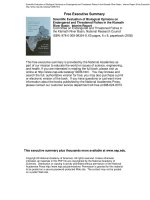

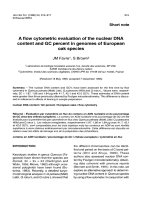
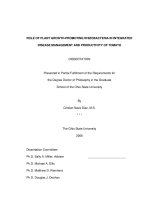

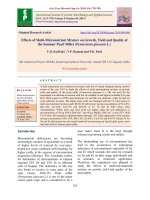

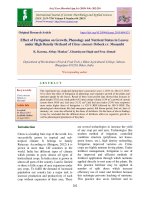
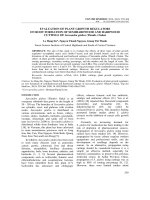
![Genetic analysis for micronutrients and grain yield in relation to diverse sources of cytoplasm in pearl millet [Pennisetum glaucum (L.) R. Br.]](https://media.store123doc.com/images/document/2020_01/13/medium_ion1578932058.jpg)